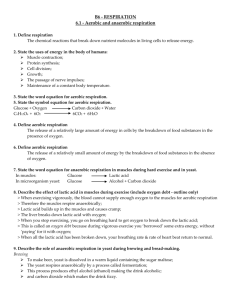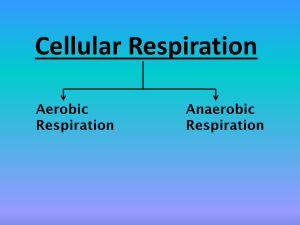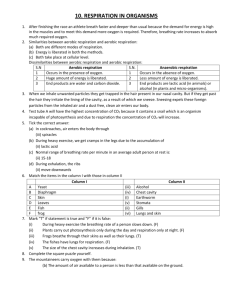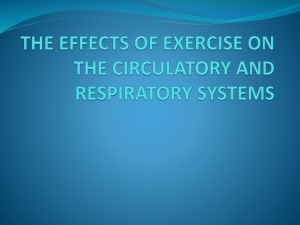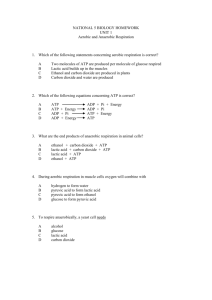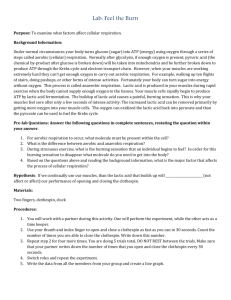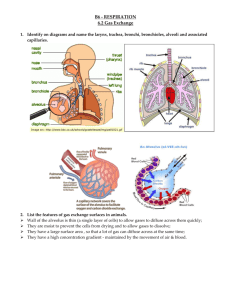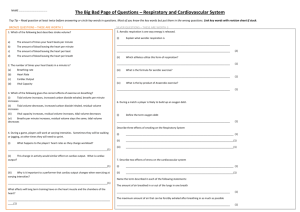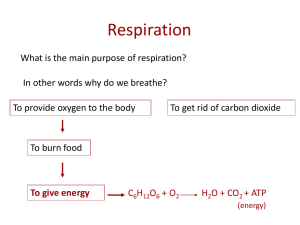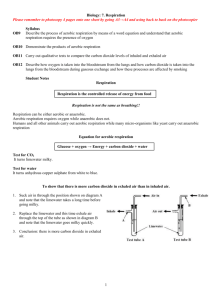B6 Revision notes
advertisement
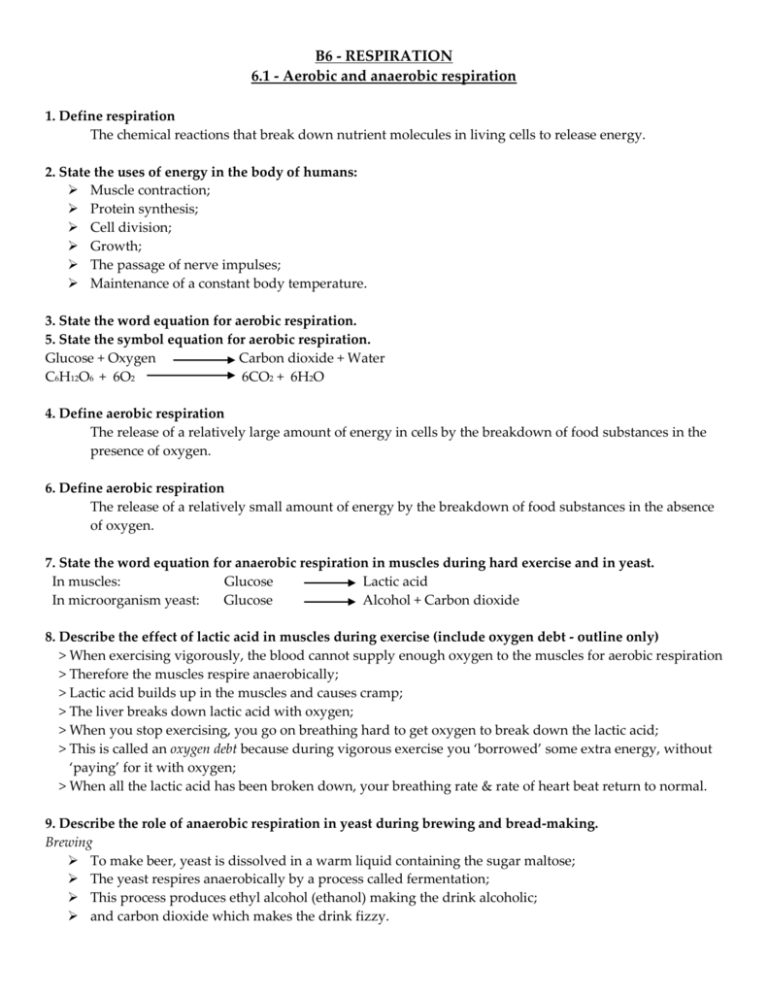
B6 - RESPIRATION 6.1 - Aerobic and anaerobic respiration 1. Define respiration The chemical reactions that break down nutrient molecules in living cells to release energy. 2. State the uses of energy in the body of humans: Muscle contraction; Protein synthesis; Cell division; Growth; The passage of nerve impulses; Maintenance of a constant body temperature. 3. State the word equation for aerobic respiration. 5. State the symbol equation for aerobic respiration. Glucose + Oxygen Carbon dioxide + Water C6H12O6 + 6O2 6CO2 + 6H2O 4. Define aerobic respiration The release of a relatively large amount of energy in cells by the breakdown of food substances in the presence of oxygen. 6. Define aerobic respiration The release of a relatively small amount of energy by the breakdown of food substances in the absence of oxygen. 7. State the word equation for anaerobic respiration in muscles during hard exercise and in yeast. In muscles: Glucose Lactic acid In microorganism yeast: Glucose Alcohol + Carbon dioxide 8. Describe the effect of lactic acid in muscles during exercise (include oxygen debt - outline only) > When exercising vigorously, the blood cannot supply enough oxygen to the muscles for aerobic respiration > Therefore the muscles respire anaerobically; > Lactic acid builds up in the muscles and causes cramp; > The liver breaks down lactic acid with oxygen; > When you stop exercising, you go on breathing hard to get oxygen to break down the lactic acid; > This is called an oxygen debt because during vigorous exercise you ‘borrowed’ some extra energy, without ‘paying’ for it with oxygen; > When all the lactic acid has been broken down, your breathing rate & rate of heart beat return to normal. 9. Describe the role of anaerobic respiration in yeast during brewing and bread-making. Brewing To make beer, yeast is dissolved in a warm liquid containing the sugar maltose; The yeast respires anaerobically by a process called fermentation; This process produces ethyl alcohol (ethanol) making the drink alcoholic; and carbon dioxide which makes the drink fizzy. Bread making Yeast is mixed with water and sugar to activate it; The mixture is added to flour to make dough, and left in a warm place; The dough rises as the yeast respires and releases carbon dioxide, which gets trapped in the dough; When the dough is cooked, the high temperature kills the yeast and evaporates any alcohol formed; Air spaces are left where the carbon dioxide was trapped, which gives the bread a light texture. 10. Compare aerobic respiration and anaerobic respiration in terms of relative amounts of energy released. Aerobic respiration Uses oxygen No alcohol or lactic acid made Large amount of energy released from each molecule of glucose Carbon dioxide made Anaerobic respiration Does not use oxygen Alcohol (in yeast and plants) or lactic acid (in animals) is made Much less energy released from each molecule of glucose Carbon dioxide is made by yeast and plants, but not by animals 6.2 Gas Exchange 1. Identify on diagrams and name the larynx, trachea, bronchi, bronchioles, alveoli and associated capillaries. 2. List the features of gas exchange surfaces in animals. Wall of the alveolus is thin (a single layer of cells) to allow gases to diffuse across them quickly; They are moist to prevent the cells from drying and to allow gases to dissolve; They have a large surface area , so that a lot of gas can diffuse across at the same time; They have a high concentration gradient - maintained by the movement of air & blood. 3. Explain the role of mucus and cilia in protecting the gas exchange system from pathogens and particles. Air Diagram of lining of trachea The lining contains two kinds of cells: Goblet cells and ciliated cells; Goblet cells make sticky, slimy mucus; Many of the bacteria in the air and dust particles get trapped in the mucus; Ciliated cells have tiny, microscopic hair on them called cilia; The cilia beat in unison, and sweep the mucus upwards, towards the back of the throat. 4. Describe the effects of tobacco smoke and its major toxic components (tar, nicotine, carbon monoxide, smoke particles) on the gas exchange system. Chemical Carbon monoxide Nicotine Smoke particles Tar Effects on gas exchange system A poisonous gas; combines with hemoglobin in RBC, preventing them from transporting oxygen Addictive; increases heart rate & blood pressure Irritate the air passages, causing inflammation & increased mucus production, resulting in chronic bronchitis; coughing and the presence of particles in the alveoli can lead to emphysema (breaking the walls of the alveoli) A carcinogen - increases the risk of lung cancer; lines the air passages, increasing mucus production and paralyzing and damaging cilia, causing bronchitis. 5. State the differences in composition between inspired and expired air. Gas Nitrogen Oxygen Carbon dioxide Water vapour Inspired air % 79 21 0.04 Variable Expired air % 79 16 4 Saturated Explanation Not used or produced by body processes Used up in the process of respiration Produced in the process of respiration Produced in the process of respiration, moisture evaporates from the surface of the alveoli 6. Use lime water as a test for carbon dioxide to investigate the differences in composition between inspired and expired air. IGCSE Biology (Jones & Jones), p. 122, activity 9.5 ‘comparing the CO2 content of inspired & expired air’. 7. Investigate and describe the effects of physical activity on rate and depth of breathing. 8. Explain the effects of physical activity on the rate and depth of breathing. The volume of air breathed in and out during normal, relaxed breathing is about 0.5 litres (the tidal volume); The breathing rate is about 12 breaths per minute; During exercise, the volume inhaled (depth) increases to about 5 litres ( depending on the age, sex, size and fitness of the person); The maximum amount of air breathed in and out in one breath is the vital capacity; The breathing rate can increase to over 20 breaths per minute; The total lung volume is greater than the vital capacity because some air always remains in the lungs (otherwise the lungs would collapse and the alveoli walls would stick together) Breathing rate and depth increase to absorb more oxygen for the muscles as exercising muscles need to respire more to get more energy.
